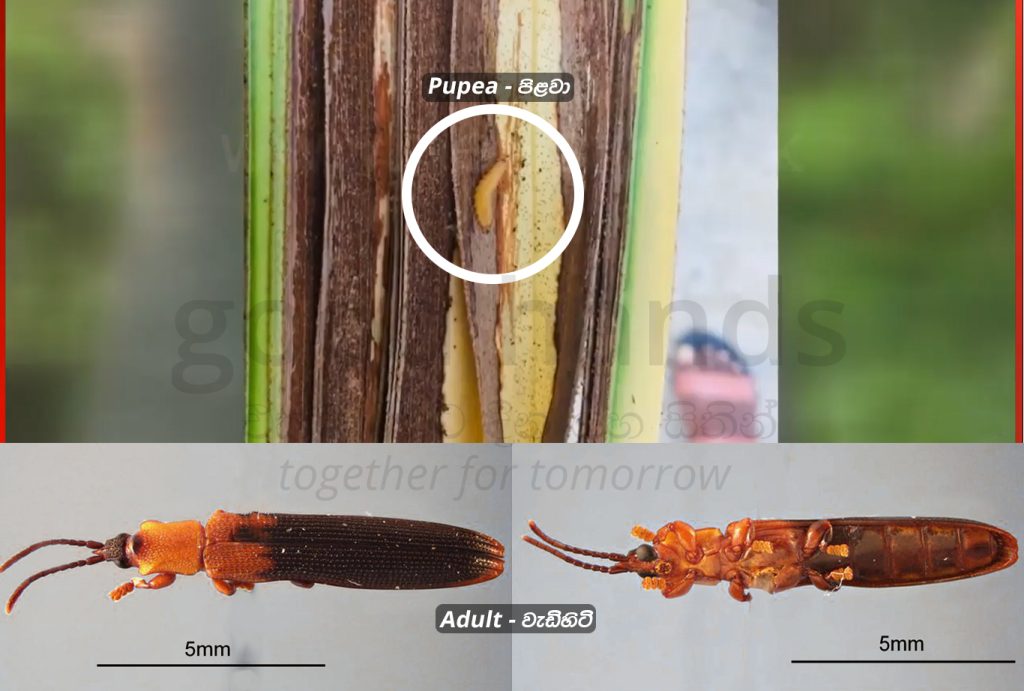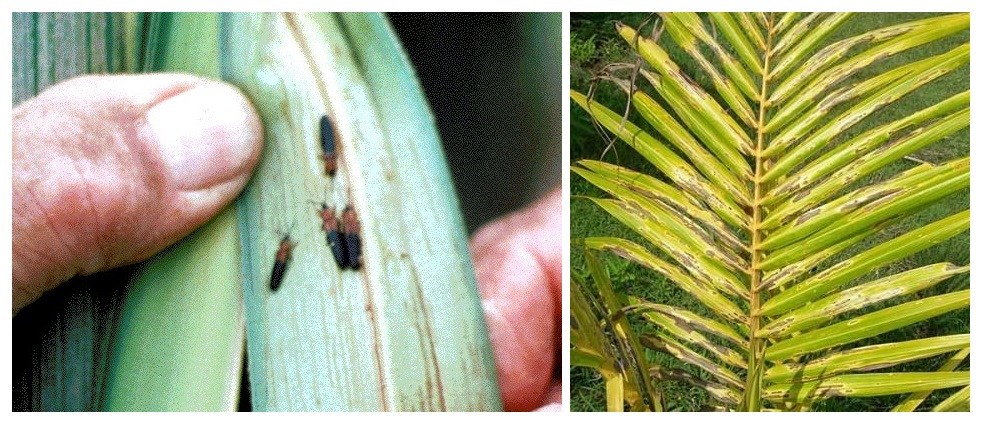Sri Lanka’s vibrant ecosystem faces a new threat: a new insect pest, the Brontispa beetle (Brontispa longissima). This invasive pest has recently been observed, causing significant damage to coconut plantations in the Southern Province, particularly in areas such as Galle, Dodanduwa, Matara, and Kamburupitiya. The Brontispa beetle, commonly referred to as the “Coconut Hispine Beetle,” shares striking similarities with the notorious “Plessispa Beetle” (Plesispa reichei), which is also infamous for its destructive impact commonly on young coconut plants.
Identification and Life Cycle

The life cycle of the Brontispa beetle encompasses four distinct stages. There are eggs, larvae, pupa, and adults. The egg stage is characterized by brown-shaped eggs measuring about 1.5 mm in length and 1 mm in width. This stage lasts for approximately 3 to 7 days. The larvae emerge as white upon hatching and reside within the unopened coconut leaves. The pupal phase, lasting for 4 to 6 days, follows the larval stage. During this period, the pupa assumes a light yellow-brown hue. It continues to derive nourishment from the unopened coconut leaves. As the Brontispa beetle enters adulthood, it grows to a size of 8 to 10 mm in length and 2 mm in width. The adult stage, which spans around 2-3 months, is marked by a reddish-brown body and a light brown head. This phase continues to cause damage to the coconut plant.
Adults and larvae avoid light, and at the same time, the adults fly at night and feed on the leaflets of the unopened coconut fronds.
Damage Characteristics and Effects

The presence of Brontispa beetle damage is evidenced by the appearance of decayed red-brown stripes running parallel to the midrib of the unopened coconut frond. As these leaves unfurl, the initially observed rotting strips extend and assume a grey-brown hue, resembling a burnt coconut leaf. The plant’s age does not limit this damage and affects young and mature coconut plants. The consequences of Brontispa infestation include stunted plant growth and a significant reduction in yield, which can lead to economic losses for coconut growers.
Suppression Strategies
Biological Control
Efforts to combat Brontispa beetle infestations include a range of natural and chemical strategies. Identifying and treating plants showing signs of pest damage is crucial to prevent further spread. Some countries have effectively deployed natural enemies to target various life stages of the pest, including eggs, larvae, and adults. Notable among these natural predators is the earwig (Chelisoches morio), which feeds on Brontispa beetle larvae. In addition, entomopathogenic fungi such as Metarhizium anisopliae and Beauveria bassiana have successfully controlled the beetle population.

Chemical Control
For chemical control, the Coconut Research Institute recommends the trunk injection of Monocrotapus, a specific insecticide. However, it is advised that such interventions be carried out under the guidance of qualified officers to ensure their effectiveness and minimize unintended consequences.

Stay up-to-date with the latest information on the Brontispa beetle and its impact by following goodhandslk on our Facebook page.


ප්රතිචාරයක් සටහන් කරන්න